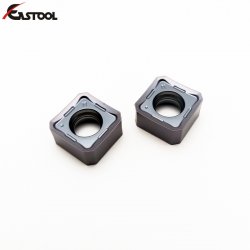The Case For Testing Tools

For production parts with various holes, the way to save time and cost with a high speed machining center would appear to be obvious. Simply put, the machine can move faster. Workpiece machinability may limit how quickly each feature of the part can be cut, but certainly the cycle time can still be reduced if the rapid traverse moves and tool changes are performed more quickly. A certain significant fraction of the processing time can be saved in this way.
But is this the best way for a high speed machine Indexable Inserts to improve productivity?
Not necessarily, say representatives of machine tool builder Toyoda. Machining centers that use linear motors for axis motion in place of rotary motors and ballscrews can improve the process by taking advantage of a different approach to machining holes. Because of their ability to maintain tight contouring accuracies at high feed rates, these machines can generate holes through circular milling to a level of speed and precision that may rival that of boring and other straight-line approaches. When one tool efficiently produces many different-sized holes in this way, the speed, capability and economy of the process can all improve.
Horizontal machining centers offered by Toyoda (U.S. headquarters in Arlington Heights, Illinois) include both fast machines with ballscrews and even faster machines that use linear motors. For these latter machines, tungsten carbide inserts the higher cost is an important drawback. Also important is the fact that quality ballscrew machines have done quite well, performing effectively even in applications where high feed rates are involved. But milling in circles is one application that does play to a linear motor strength—specifically, its capacity to achieve speed and precision at the same time.
When a machining center uses ballscrews, the rotary motor, ballscrew and drive train make up a mechanical linkage with various small opportunities for backlash and compliance. The overall result of this “play” is a measurable motion error whenever an axis reverses direction. The axis reversal error presents a problem in circular milling, because both the X and Y axes have to reverse direction in the course of feeding the machine through a circle. A higher feed rate only increases the magnitude of this error. As a result, a hole milled rapidly on a ballscrew machine is prone to fail a tight specification for hole roundness. The more standard approaches to hole making are therefore preferred.
A linear motor machine does away with much of the axis reversal error because it does away with the mechanical assembly. The linear motor moves along the axis, carrying with it the moving element of the machine. Because of this, the linear motor machine can mill out a high-precision hole at high feed rates. It can mill a precise hole so quickly, in fact, that it allows milling to rival more conventional hole-making approaches.
When the process relies on milling for hole making in this way, a variety of savings may result. Frank Petravicius, an account manager based in Toyoda’s Wixom, Michigan, office, summarizes the potential savings as follows:
The Carbide Inserts Website: https://www.cuttinginsert.com/product/lnmu-insert/




Ingen kommentarer endnu